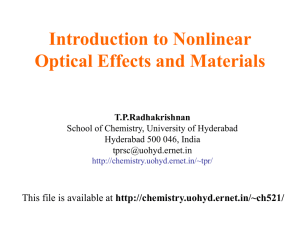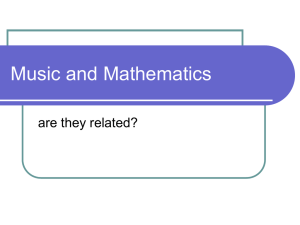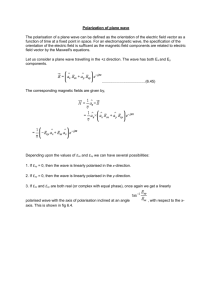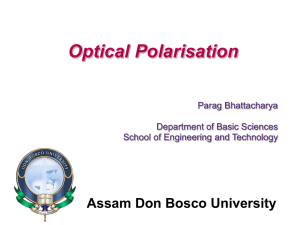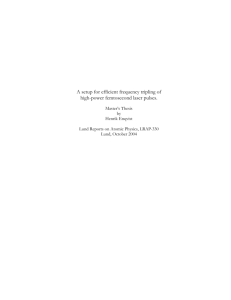Document
advertisement
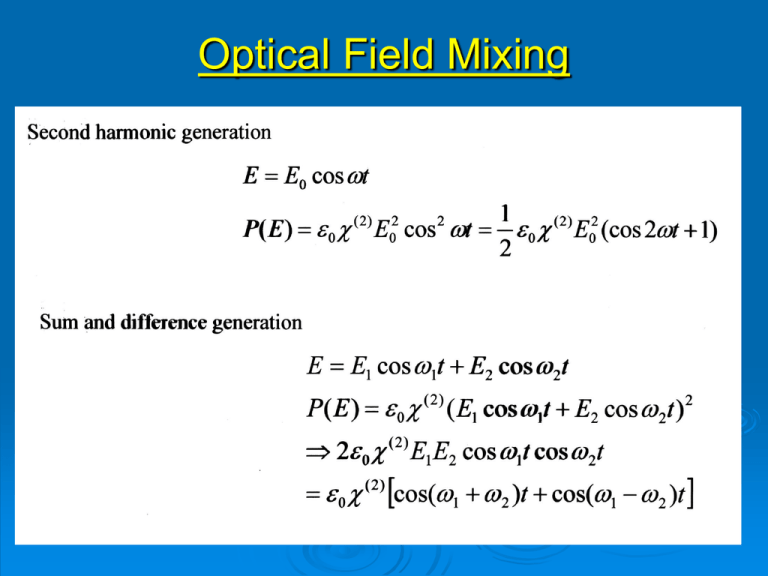
Optical Field Mixing Oscillating Polarisation Optical polarisation Fundamental polarisation SH Polarisation Constant (dc) polarisation SHG: Efficiency factors The generated second harmonic has to remain “in step” with the fundamental wave which produces it. This is known as phase-matching. Coherence length Efficiency Factors 1. Walk-off 2. Beam Divergence ø θ Angle Index ellipsoid To match the indices the fundamental wave propagates as the ordinary wave while the second harmonic as the extraordinary. Directions and fields in SHG Phase-matching The idea is to make use of dispersion to achieve a common index of refraction and thereby a common propagation velocity in the medium. Phase-matching - Index ellipsoid In type I phasematching the fundamental and second harmonic waves travel as waves of different types, i.e. one as the ordinary the other as the extraordinary wave. The required condition is then n1(2ω)=n2(ω) Computing the phase-match angle For the extraordinary wave the index ellipse gives: So, if we require ne (2ω,θ) = no(ω) then, Walk-off The second harmonic wave can walk away from the fundamental. S and k are not collinear. Walk-off calculation Maximising the SHG output the angle θ to z-axis is equal to θm When the angle to the x-axis equals 45° When the input beam has a low divergence When the crystal temperature is constant (since n = f(T)) When the crystal is relatively short (coherence length) When 45 degree, z-cut •Efficiency maximised •Little or no walk-off •High angular tolerance Depletion & Focus Coupled Equations now give a tanh solution Depleted Input Beam For depletion under perfect phase-matching: Where the coupling is given by: Which for low depletion reduces to: Which is identical to our earlier expression, noting Optical Parametric Oscillator ω3 pump Nonlinear X’tal Conditions for the generation of new optical frequencies: 1 2 3 Energy k1 k2 k3 1n1 L m c 2 n2 L s c Momentum Modes Modes Parametric processes I Parametric processes II Parametric Processes III Single Photon Sources Parametric-down conversion schemes: (a) Type-I; (b) Type-II, and (c) Correlated pairs – polarisation Entanglement. Example: generation of 243nm Example: summing in KDP For this symmetry group: For the second harmonic to propagate as the extraordinary wave: Frequency summing in KDP The form of the polarizability tensor for these negative uniaxial crystals with 42m symmetry class enables generation of the SHG as an extraordinary wave. The expression for deff maximises when θ = 90° and Φ = 45°, i.e., Phase-matching angles The fundamental is plane-polarized in the x-y plane – it propagates as an ordinary wave and generates a SHG polarization along z. This has to be project along k Frequency summing in KDP Energy conservation (ω): Indices must satisfy (k): Calculating the phase-matching angle gives almost 90°, i.e., Temperature tuning the crystal Since the refractive index is temperature dependent it may be possible to phase-match at 90° by exploit this variation, i.e., Solve to find ΔT. Finally, the crystal can be cut so as to have Brewster faces for the fundamental beams; the SHG is orthogonally-polarised and suffers some Fresnel loss in a single pass out of the crystal. The final crystal design


